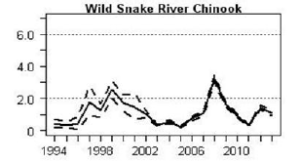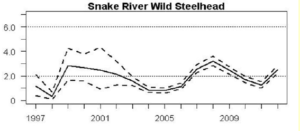So… How are the Snake River Salmon and Steelhead REALLY doing?
Summary
In 2016 the fish returns at Lower Granite dam are down for all categories compared to both the 10 year average and 2015 (except for Sockeye salmon, which were nearly extirpated in 2015). A total of 216,445 salmon and steelhead returned to Lower Granite Dam in 2016, a 33% reduction from 2015, while pre-dam returns were in the millions. These precipitous declines should come as no surprise. They were predicted in the 2015 Salmon White Paper which was distributed to Pacific NW state representatives as well as federal agency representatives. Of special note are salmon “jack” returns which are considered a predictor of future fish returns. Versus the 10 year average, Spring Chinook are down 57%, Summer Chinook are down 69%, and Fall Chinook are down 31%. Five year reviews by NOAA show minimal improvement in the risk-status of ESA-listed salmon and steelhead despite a billion taxpayer dollars being spent on system improvements. Current NOAA recovery plans are predicted to NOT achieve fish recovery. Pacific NW state fisheries reports show that smolt-to-adult ratios have not improved either and still show Snake River fish returns are not meeting criteria for species survival.
2016 Fish returns at Lower Granite dam (all data from Fish Passage Center).
| Fish Run | vs. 10 Year Average Returns | vs. 2015 Returns |
| Spring Chinook | -5% | -40% |
| Summer Chinook | -39% | -26% |
| Fall Chinook | -7% | -34% |
| Total Chinook | -11% | -37% |
| Sockeye | -17% | +85%* |
| Hatchery Steelhead | -40% | -24% |
| Wild Steelhead | -47% | -40% |
| Total Steelhead | -42% | -28% |
*In 2015 lethally warm reservoir temperatures nearly wiped out Snake River Sockeye salmon.
From the 2016 5-Year Review: Summary & Evaluation of Snake River Sockeye, Spring-Summer Chinook, Fall-Run Chinook and Steelhead, National Marine Fisheries Service, West Coast Region
Snake River Sockeye Salmon
“At this point in time, natural production of anadromous Snake River Sockeye Salmon remains limited to extremely low levels in Redfish Lake, one of five Sawtooth Valley lakes believed to have historically supported production. As a result, the overall biological status relative to recovery goals is high risk.”
Snake River Spring/Summer Chinook Salmon
“The majority of populations (27 of 28) in the Snake River spring/summer Chinook salmon ESU remain at high overall risk, with one population (Chamberlain Creek in the Middle Fork Salmon River MPG) improving to an overall rating of Maintained due to an increase in abundance (NWFSC 2015). Natural-origin abundance has increased over the levels reported in the prior review for most populations in this ESU, although the increases were not substantial enough to change viability ratings.”
Snake River Fall-run Chinook Salmon
“Given the combination of current ratings of low risk for abundance/productivity and moderate risk for spatial structure/diversity summarized above, the Snake River fall-run Chinook salmon ESU is rated at low risk relative to ICTRT criteria. The rating reflects ongoing uncertainty regarding the population’s productivity, and whether recent increases in natural-origin abundance can be sustained over the long term. It also reflects concerns with the high levels of hatchery-origin spawners in natural spawning areas, and the potential for selective pressure imposed by current hydropower operations and cumulative harvest impacts.”
Snake River Steelhead
“Four out of the five MPGs are not meeting the specific objectives in the draft recovery plan… and the status of many individual populations remains uncertain (NWFSC 2015). Overall, the information analyzed for this status review does not indicate a change in biological risk status (NWFSC 2015).”
From the 2016 Proposed ESA Recovery Plan for Snake River Spring/Summer Chinook Salmon & Snake River Steelhead, National Marine Fisheries Service, West Coast Region
“Over $1 billion has been invested since the mid-1990s in baseline research, development, and testing of prototype improvements, and construction of new facilities and upgrades.”
“NMFS estimates that recovery of the Snake River spring/summer Chinook salmon ESU and steelhead DPS, like recovery for most of the ESA-listed Pacific Northwest salmon and steelhead, could take 50 to 100 years. This recovery plan contains an extensive list of actions to move the ESU and DPS towards viable status; however, the actions will not get us to recovery.”
From the September 26, 2016 NOAA Memo “Preliminary survival estimates for the passage of spring-migrating juvenile salmonids through Snake and Columbia River dams and reservoirs, 2016”
Hydropower system survival estimates: Snake River trap above Lower Granite to Bonneville dam.
| Year | Steelhead (hatchery & wild) | Yearling Chinook salmon (hatchery & wild) | Sockeye salmon (hatchery & wild) |
| Average, 1993- 2016 | 45% | 49% | 41% |
| 2014 | 77% | 50% | 71% |
| 2015 | 36% | 39% | 37% |
| 2016 | 44% | 47% | 12% |
From the 2016 Comparative Survival Study SAR Patterns: Snake and Mid-Columbia
SAR (smolt to adult return ratio) is a measure of fish survival, or the % of smolts that return as spawning adults. The Northwest Power & Conservation Council’s goals are 2% for mere survival of the species and 6% for recovery of the species. Overall, Snake River Chinook and steelhead SARs have only been above 2% in 5 of 20 years in recent history (and never above 6%). These results are in spite of increased spill and barging around the dams. In contrast, Mid-Columbia Chinook and steelhead are generally meeting the NPCC SAR goals and have SAR ratios 2.3X – 3.4X greater than Snake River wild SARs. Keep in mind that Snake River salmon and steelhead pass over 8 dams… 4 on the Columbia and 4 on the Snake. Mid-Columbia fish only pass 1- 4 lower Columbia dams. If the 4 lower Snake River dams were removed, Snake River salmon and steelhead would have very similar migration and spawning conditions, which should lead to fish recovery.

Chart to left shows historic decline of Snake River salmon and steelhead associated with the construction of the 4 lower Snake River dams.


